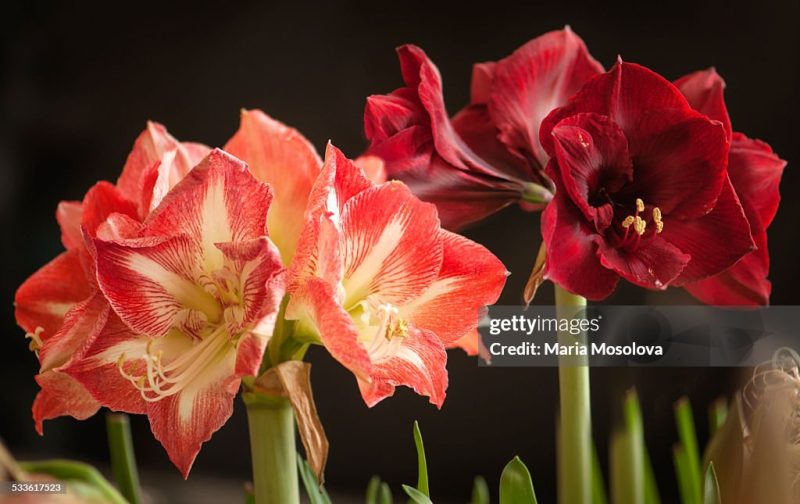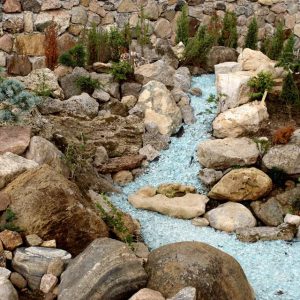By Scott Mcintaggart, Master Gardener In-Training, SCMG
Annually, I undoubtedly receive a beautiful Amaryllis plant as a gift during the Christmas Season (and if I don’t, I purchase one). Their stunning funnel shaped cluster of flowers can bloom for up to three weeks and they come in variety of colors and sizes. However, it was not until last year that I stop throwing my Amaryllis away after it bloomed and discovered that with proper care, it can bloom annually for many years.
In its native environment of South and Central America, where summers are long, hot and dry, the Amaryllis plant continues to grow following blooming. In this environment the bulb does not actually go through a true dormancy phase but rather a rest period prior to blooming again. During this rest period its leaves continue to grow, ensuring photosynthesis and energy storage within the bulb for future flowering. Eventually the leaves turn yellow and die back, at which time the plant stops growing for a few weeks. Once the rest period ends the plant starts re-growth, with leaves emerging first, followed by the stalks, and eventually the blooms.

In order for the Amaryllis to survive in our environment (Simcoe County, Ontario. Canada), we must emulate these natural occurring conditions, by taking the following steps:
- Once the flowers have faded and died, use a sharp clean knife or pruners to cut off the stalk one half to one inch above the blub. The flower and stalks should be removed promptly after the bloom has died to prevent seeds from forming which will deplete the plants energy storage.
- It is important to keep the leaves and any new foliage that is emerging. The leaves assist in photosynthesis, creating food for the bulb to restore its energy for next year’s blooms. The plant should be placed in a warm sunny place and the soil should be kept moist and watered when the top two inches feel dry. The plant should be fertilized with half strength houseplant fertilizer every two to three weeks.
- In spring the Amaryllis can be moved outdoors once the risk of frost has passed and temperatures are above 50 degrees Fahrenheit (F) or 10 Celsius (C)). It is essential that the plant be harden off by initially placing the potted plant in partial shade, bringing it into sunlight intermittently over a period of a week. Following this hardening off period, the plant can be placed in a location that receives at least 6 hours of full sun to partial shade daily.
- In late summer/early fall the leaves will start to turn yellow. This is an indication that the plant is entering its dormant (rest) period. At this point you can allow the plant to go through its natural life cycle which includes setting its own bloom time. This is accomplished by placing it in a cool indoor location with indirect sunlight and temperatures between 50 and 60 degree F (10-15C). Fertilization should be stop at this point however watering should be continued it to keep the soil barely moist. The plants leaves will eventually turn brown and die off naturally. Eventually, new leaves will appear at which time the plant should be moved to a sunny, warm spot with temperatures between 70 and 75 degrees F (21-24C) . Regular watering and fertilization should be resumed at this time.
- Alternately, the plants bloom time can be timed or forced. This can be accomplished by stopping water and fertilization 8 to 12 weeks prior to the desired bloom time. Once the leaves turn yellow and brown, they should be cut back. The plant should be a placed in a cool, dry space with indirect light. This space could be a garage, cool basement or covered porch as long as the temperature remain around 50 -55 F (10-12 C). Once temperatures fall below 50 F (10C) the plant should be placed in a cool indoor space with indirect sunlight, with temperatures maintained between 50 and 60 F (10-15 C).
- Once the 8 to 12 weeks have past (dependent on your calculation of bloom time) the plant should be moved to a sunny location with temperatures between 70 and 75 F (21 and 24 C). Watering and fertilization (with a high phosphorus content) should be restarted at this time. For example, if you wish to have your Amaryllis bloom during the Christmas Holiday Season, you should move the plant to a warm sunny environment and begin the watering and fertilization routine in mid to end of October.
- Once the Amaryllis has bloomed again, the after-bloom care must be restarted to prepare for the following year.
Additional facts about Amaryllis Care:
- An Amaryllis with wilting leaves is an indication of underwatering.
- Plants should be monitored regularly for mealybugs or spider mites and treat with a horticultural oil
- Repotting your Amaryllis is only required every few years.
- An Amaryllis requires very little extra soil around the bulb.
References
- Crossley,H. January 24, 2023. House and Home. What do you do with and amaryllis after it blooms? Don’t discard it- follow these tips instead. https://www.homesandgardens.com/gardens/what -do-you-do-with-…
- Hassani,N. May 5, 2024. The Spruce. What to Do with Amaryllis After It Blooms. https://www.thespruce.com/amaryllis-care-after-blooming-5211111
- Robby, July 3, 2024. What To Do With Amaryllis Buls After Blooming- A Complete Guide. https://stonepostgardens.com/what-to-do-with-armaryllis-bulb/





